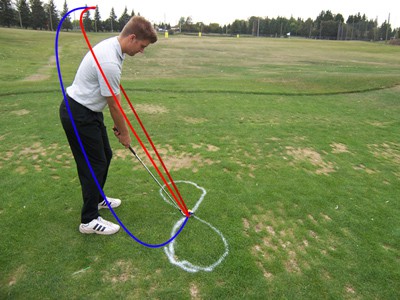
The fault being demonstrated by the lines in this picture is called coming over-the-top. This classic fault is very common with slicers, and is most often characterized by a big looping slice that starts left of the target line (right-handers anyway). This move, of hacking down at the ball from a vertical position with the arms and upper body results in collapsed arms into impact, a loss of power, direction (and most likely big divots). The clubhead gets too far away from the body on the downswing and results in a swing path that travels along the red line, outside of the target line, and then back in. The key to solving this problem is to get the clubhead more behind a player so they can attack the ball from a shallower angle.

To help cure this swing fault, our goal is to encourage a flatter approach into the ball. What most players don’t realize is that this happens naturally when you play a ball above your feet. In order to help feel the proper path into the ball, and engrain the move, it’s as simple as hitting a bunch of balls from a sidehill lie, with the ball 3-4 inches above your feet. In order to achieve solid contact you’ll find your swing getting flatter, and your approach into the ball flatter. An over-the-top swing from this type of lie is nearly impossible. Think of making a “baseball swing” and you’ll be well on your way to create a better swing path into the ball.
There’s a reason you tend to hook a ball from a lie with the ball above your feet – use it to your advantage if you’re suffering from an over-the-top slice.
